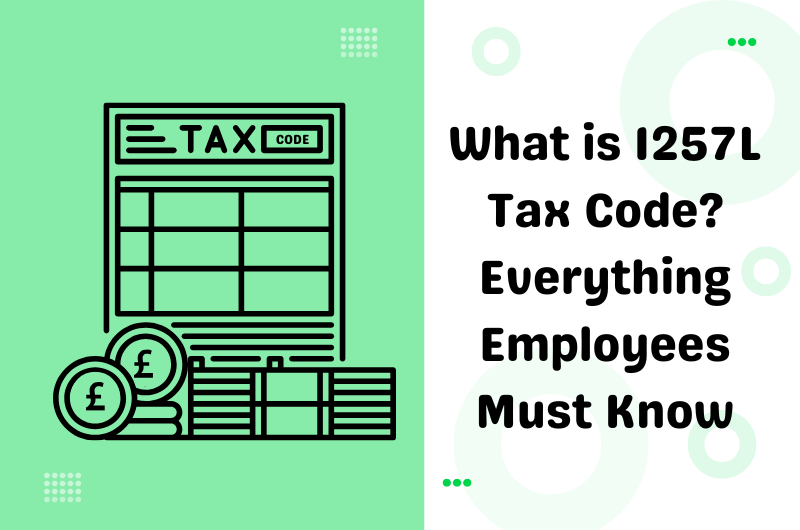What is 1257L Tax Code? Everything Employees Must Know
In the UK, every employee’s salary is subject to the mandatory deductions of income tax and NICs under the PAYE system. This is why understanding your tax code is imperative to ensure you pay the correct amount of income tax. Notably, each year, HMRC assigns tax codes to employees based on their individual circumstances, and these codes fundamentally determine how much tax is deducted from your salary through the Pay As You Earn (PAYE) system. This brings us to the 1257L tax code, one of the most common codes that is applied to the employees’ income. Hence, this guide shines light on what is 1257L tax code, when it is applied by HMRC, and how it affects your take-home pay.
What Is 1257L Tax Code?
The 1257L tax code is the most commonly applied tax code in the UK and is issued to the majority of employees. According to HMRC, the 1257L tax code is the standard tax code for most employees in the UK for the 2025/26 tax year. Essentially, it applies to people who are entitled to the full Personal Allowance, the income an employee earns before they start paying income tax. The 1257L tax code is assigned to individuals who have one job with no additional/untaxed income, benefits, or company perks that might affect their tax code.
What Does The 1257L Tax Code Indicate?
We can break down the 1257L tax code to understand what the letter L and the digits 1257 indicate. Here’s what the code indicates:
- The number “1257” represents that you can claim a tax-free Personal Allowance of £12,570 per year. Subsequently, you can earn up to £12,570 in income without paying any income tax.
- The letter “L” means you are eligible for the standard Personal Allowance and that you are not subject to any special tax code adjustments.
In addition, if your tax code is 1257L and you are paid monthly, you will receive £1,047.50 of tax-free income each month as £12,570 ÷ 12 = £1,047.50.
For greater clarity on how tax code 1257L works, consider the following scenario. Your income equals £30,000 a year. You have no other sources you can earn any additional income or benefits. As an outcome, your employer will issue the tax code 1257L on your payslip, which allows you to earn £12,570 tax-free income. Hence, your remaining income after subtracting the personal allowance is £17,430 (£30,000-£12,570), and it will be taxed at the basic rate of 20%.
However, it is significant to highlight here that if your income exceeds the threshold of £12,570 in the tax year, you will be taxed according to the applicable income tax rates of 20% (Basic rate), 40% (Higher rate), and 45% (additional rate). Visit the government website to learn more about the income bands and their corresponding tax rates.
When learning what is 1257L tax code, it might also be relevant to mention that the 1257L becomes an emergency tax code only if it is followed by ‘W1’, ‘M1’ or ‘X’. Generally, HMRC assigns the emergency tax codes if a new employee does not have a P45. you can learn more about the emergency tax code M1 by reading our following guide:
Similarly, there are other important tax codes, each with a specific purpose. You can gain an in-depth insight into the UK tax codes by reading our comprehensive guides:
- What is a BR tax code in the UK? A guide for employees
- How to change my BR tax code? A guide for employees.
- Why has my tax code changed? A guide for employees.
- What does a K tax code mean? A guide for employees.
Concluding Remarks:
Every employee must grasp the nettle of what is 1257L tax code because this code is instrumental in helping employers calculate how much tax to deduct from an employee’s income. It ensures that individuals receive their full Personal Allowance before income tax is applied and deductions are made. While the 1257L is the most common tax code, in particular for single-job holders having additional income, it is always worth checking that your tax code reflects your current financial situation. Further down the line, both employees and employers must comprehend tax codes like 1257L to avoid errors in tax deductions and ensure compliance with HMRC guidelines. Nevertheless, even if you are having trouble decoding the puzzle of tax codes, you can always count on the expertise of a well-versed and skilled accountant, such as those on the platform of Payrollservices.accountants. Our knowledgeable team can assist your business with accurate payroll processing, help identify tax code errors, and ensure employees are taxed correctly. Ultimately, whether you are running payroll or checking your own payslip, our comprehensive guidance can save you precious time, avoid penalties, and ensure peace of mind.
Disclaimer: The content contained in this blog is exclusively aimed at informational purposes and should be treated as such. While it has been written with thorough scrutiny at the time of writing to ensure every information is correct, no warranty for the acceptance of any error or inaccuracy is given. It is not a piece of absolute financial advice, nor is it expert legal advice. Hence, it is advised to consult a professional before acting upon any information stated herein.


